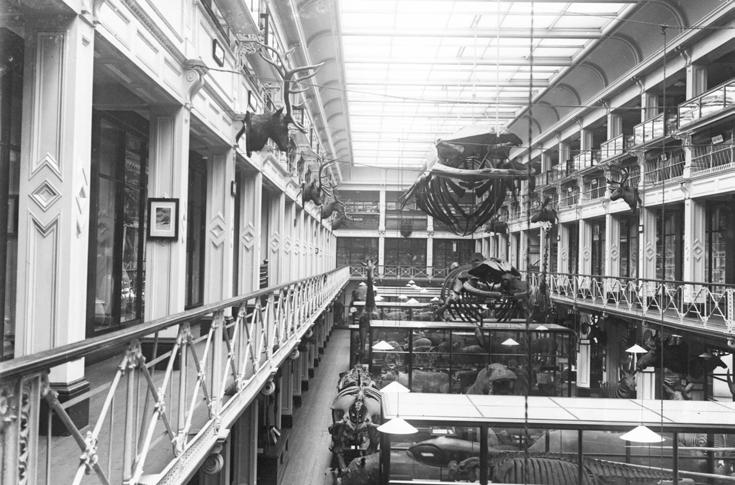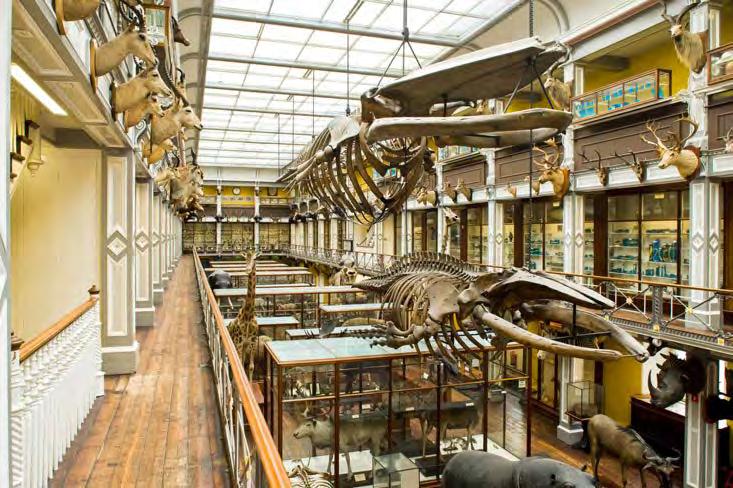
9 minute read
Breathing life into the Dead Zoo
from Museum Ireland, Vol. 27. Widdis, B. (Ed.). Irish Museums Association, Dublin (2021)
by irishmuseums
MUSEUM IRELAND 2020
Breathing life into the Dead Zoo
Advertisement
Nigel T. Monaghan
Introduction
The National Museum of Ireland – Natural History is known to many visitors as ‘The Dead Zoo’, which is just one indicator of the affection and interest in this historic museum for generations of locals. As detailed in a previous article in this journal, it was due to see major refurbishment in 2007.1 At that time, there was a strong economy to support this state-funded museum, but as with the financial situation worldwide, that was to change before the building project could start in earnest. The project was reactivated in recent years by the National Museum of Ireland (NMI); with initial success in recognising that state funding should be made available. Under the National Development Plan for the period 20182027, the NMI was noted with an overall allocation earmarked under Project Ireland 2040. The Project 2040 allocation will also be supplemented by an
Exterior of the Natural History Museum building c.1900.
Credit: National Museum of Ireland
additional allocation through the Office of Public Works, which will address the design and build of a new roof for this historic building – one of the many critical areas to address.
Project planning
The management of public finances has changed since 2007 and projects of this scale must go through a rigorous Public Spending Code process.2 While the core aims of the project have not changed significantly, because a decade had passed since the first plans were put in place, it was necessary to submit a very detailed appraisal of the project to secure funding approval. A Preliminary Appraisal was approved by the Minister in late 2019, following a year of preparation and a 21,000word report submitted by the NMI.
The next stage in the Public Spending Code process is to have a Business Case prepared that must examine the project in detail and in particular the costs and how any funding may be used to get the desired results. This is not just in relation to the physical fabric of the building but must also ensure that general goals are met in terms of delivering for the public, who ultimately are the funders of the project.
The primary objectives of this project are all centred on securing a significant historic building which is still in its original use as a museum yet making it fit for the twenty-first century as a continuing major visitor attraction. The eight objectives fall under three critical goals. These combine restoration of a much-loved building in a sensitive way, with important interventions and improvements to allow it to continue to function effectively as a contemporary museum, placing the visitor at the heart of the experience. The project has three primary goals:
Goal 1: Public Engagement and Visitor Experience
• A revamped and compelling Natural History
Museum experience, that leads as Ireland’s only National Cultural Institution with a remit covering science, culture and our natural heritage. • Presenting our visitors with a 21st century visitor experience based on a contemporary and engaging interpretation of our collections, a dynamic education and learning programme,
and excellent visitor facilities. • Increase the diversity of our visitors ensuring the Natural History Museum continues to grow and engage with diverse audiences across socioeconomic and regional backgrounds.
Goal 2: Collections Care and Stewardship
• Providing an environmentally sound, sustainable, and safe building for the display and interpretation of the Natural History collections of the National Museum of Ireland. • Interpreting the collections in a manner sympathetic with the history of the building, while giving a 21st century understanding of science, nature and biodiversity both locally and globally.
Goal 3: Building Refurbishment and Renovation
• Securing the building fabric, with replacement of much of the roof structure in a style sympathetic to the original. • Achieving universal access to all floors of the public spaces. • Sensitive restoration of the interior, with improvements in visitor services and exhibitions.
Challenges to be addressed
As explored in 2007, the overall task of NMI is to conserve the ‘museum of a museum’ while improving the building in terms of collections care. Compare the two images below to see how little the interior has changed in a century. The essence of the interpretive plan can be articulated as: • It has a high density of objects on display, a major strength that should be retained. • The furnishings are part of the interior and must remain. • The taxonomic layout is a key element of a
Victorian approach. • There is a sense of discovery as visitors find their way about.
Detailed discussions will take place during the next phase of planning, and these elements will be debated at length. Engagement needs to be broadened, beyond the staff involved to date, to include a range of perspectives across stakeholders, audiences, and relevant
Upper floors of the Natural History Museum c.1910
Credit: National Museum of Ireland
Upper floors of the Natural History Museum in 2008
Credit: National Museum of Ireland


communities. There are key challenges in any interpretive plan for the restored museum, however: • Because of the display case and exhibit density, there is limited space for standard graphics. • This also means there is limited space for diverse languages to reach our increasingly diverse audiences. • There is so much we could say about the subject matter (general nature themes such as biodiversity, the stories behind individual exhibits, the stories behind each species). • There is so much that our visitors want to ask, that we will have to work out what is realistic to deliver in the gallery.
Interpretation and technology
With 10,000 exhibits in the current arrangement, even if there is some thinning of object numbers in future, space for basic labels will still be a challenge. Interpretive panels can only do so much, and staff are watching with interest as various digital and online products develop that could play a role in deepening the engagement on visitors’ own mobile devices. There is of course the eternal concern that older technologies have all gone out of date faster than museums can introduce them. The rise in smartphones indicates to us that there may be some hope in standard products that are widely used being populated with museum information. In the meantime, we will be focused on production of content and researching
of stories, so that we have the information and imagery ready for whatever solutions emerge. We are painfully aware that by the time we get there, ‘there’ could be somewhere else! The nature of the museum is partly a ‘stately home’ if not a ‘stately home of death’ as it has been termed in-house at times. There is much to learn from historic house experiences and discussions with Irish Museums Association colleagues has helped to identify the following: • New technology is as boring as old technology if the content is no good. • Menus of stories are required, providing variety and freshness. • Stories turn historic houses to historic homes.
Personal stories work – the animal’s life, the hunter’s view, the taxidermist’s skill. • Science stories work – what is this animal, or special about it? How is this species doing now?
Project development
This is a much-loved public museum, and our visitors are watching closely what we do. The most common fear expressed in reaction to news reports of funding has been ‘I hope they don’t change anything’, which is sometimes quite forcefully expressed! While the 1856 structure needs full conservation, the NMI staff are well aware that this is a listed building, and that level of preservation applies to the use and interior fittings as much as it does to the envelope of the building itself. The reality is that in its present state, the building is not in good repair, is not accessible, and is not providing the environment required for the important collections housed within.
Staff have done a significant amount of historic research over the years3 and are continuing to dig through reports and in the archives of the Royal Dublin Society (RDS) to understand the stages of development from the original design discussions around the Museum of the RDS, to the 1856 structure, to 1860s adaptations, and subsequent history. From 1877 this history continued when the Museum became part of the newly formed Museum of Science and Art, Dublin which was run and funded by the state.4 This research is an ongoing activity, which is key to appreciating this historic property, as for some reason, no original 1850-1860s drawings have been located in the Office of Public Works archives or in others. RDS archives hold the manuscript minute books of the Natural History Committee (NHC) of the RDS. These are preserved for the years 18311877 and include many details of activities not covered in published sources. The NHC oversaw expenditure and met monthly. Its minute books document major developments and payments that allow tracking of purchases of display cases, glass for cases, and ironmongery. The main building construction is not detailed, but it is recorded that several drafts of plans were presented by the Board of Works (as predecessor of the OPW) and the minute books record later alterations and connections to neighbouring buildings. The minute books in the RDS also record major acquisitions and allowed the story behind the twenty-metre-long fin whale skeleton to be uncovered.5
Work commenced in 2020 to clear access for work on the roof of the museum. Despite limitations caused by the COVID-19 pandemic restrictions, two whale skeletons were dismantled and removed. A work platform is to be installed in 2021 to close off the construction works on the roof from the museum galleries below. This is driving the project to decant all exhibits from the balcony levels, which have been closed since 2007 due to access limitations. Virtual access allows visitors to experience the interior while works are ongoing.6
Coming years will see conservation of the roof, to be followed by other major works to install lift access to upper floors and restore the museum. These aim to address all goals listed above and should future proof this significant Irish museum for many generations to come.
Nigel T. Monaghan is Keeper of the Natural History Division, National Museum of Ireland, Merrion Street, Dublin.
Dublin, Past and Future’, Museum Ireland2 17 (2007): 48–52.
2. Public Spending Code: A Guide to Evaluating, Planning and Managing Public Investment (Department of Public
Expenditure & Reform, 2019), https://www.gov.ie/en/
publication/public-spending-code/.
3. C.E. O’Riordan, The Natural History Museum, Dublin (Dublin: Stationery Office, 1983).
4. N.T. Monaghan, ‘The National Museum of Ireland’, in
The Heritage of Ireland, ed. N. Buttimer, C. Rynne, and H.
Guerin (Cork: The Collins Press, 2000), 404–12.
5. N.T. Monaghan, ‘The Two Suspended Whale Skeletons in
the National Museum of Ireland’, Irish Naturalists’ Journal 37 (2021): 141–9.
6. See ‘3D Virtual Visit’, National Museum of Ireland -
Natural History, https://www.museum.ie/en-IE/Museums/
Natural-History/Visitor-Information/3D-Virtual-Visit.









